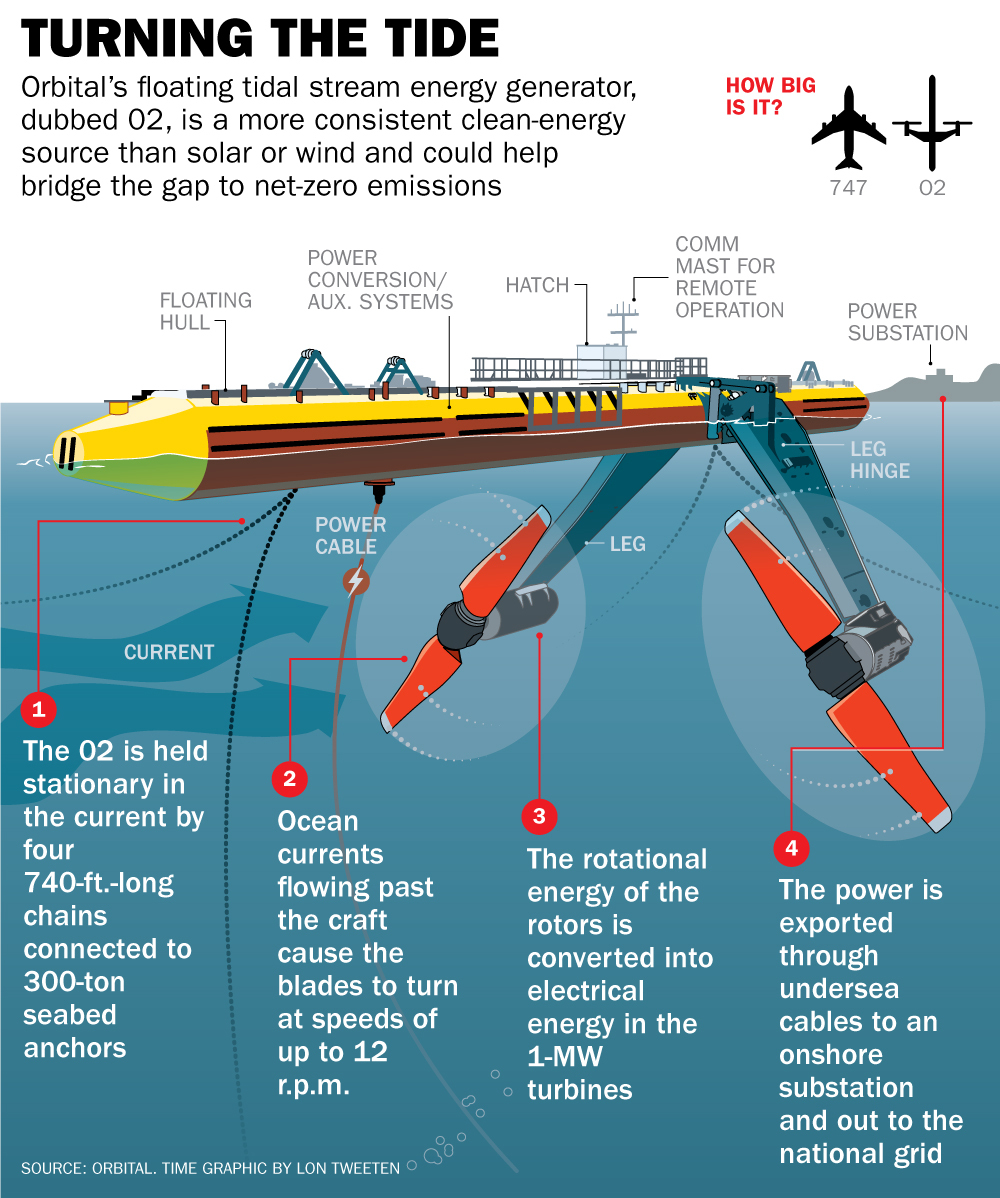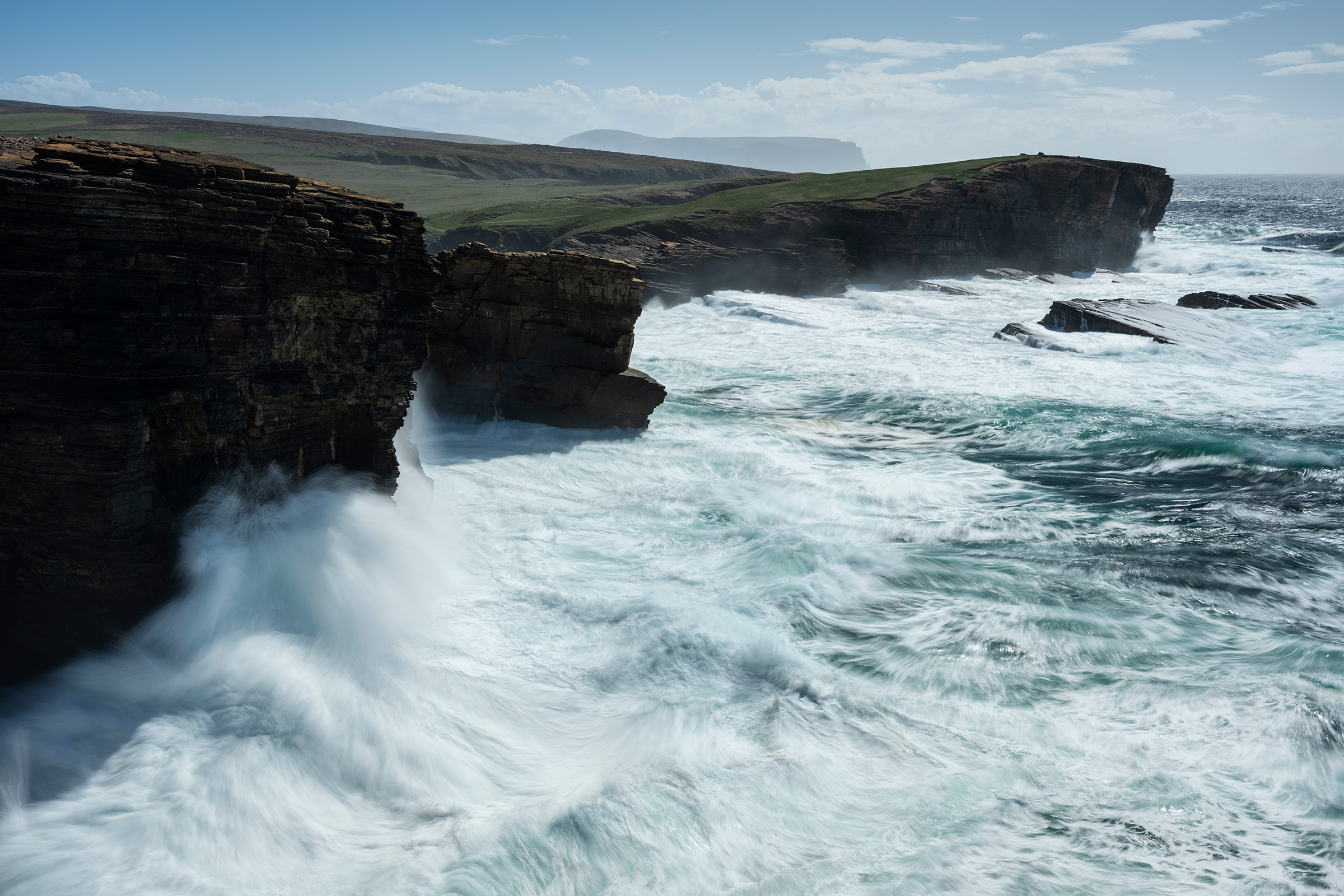In 1851, Charles Babbage, the English mathematician and inventor, found himself preoccupied with what might happen should coal mines—then and now one of the primary sources of usable energy—become depleted. He concluded that “the sea itself offers a perennial source of power hitherto almost unapplied.” Babbage was talking about tides, those lunar-guided movements of the world’s oceans, and the very synonym of dependable constancy. But while his Difference Engine, a mechanical calculator seen as a seminal fore-runner to the computer, would essentially go on to remake our world, Babbage’s ideas about tidal power drifted in the undercurrent for the next century and a half, largely the province of dreamers.
Lately, however, buoyed by successful demonstration projects and a new interest in renewable energy bolstered even further by Europe’s anticipated turning off of Russian taps, tidal energy is moving increasingly into the mainstream. While the number of megawatts produced annually by tidal—in places from Canada’s Bay of Fundy to South Korea’s Sihwa Lake—is still small, notes Donagh Cagney, policy director for the advocacy group Ocean Energy Europe, “the increase is exponential.” For example, by 2050, tidal energy is expected to account for 11% of the U.K.’s electricity, compared with just 3% today.
But in remote coastal Scotland, some residents are already getting a taste of that future. Scotland has become to tidal energy what Saudi Arabia is to fossil fuels. Cagney chalks this up to several factors, ranging from its geography—the country is blessed with some of the world’s fastest-moving tidal sounds—to its experience in working with offshore oil extraction. For those reasons, it has for almost two decades hosted the world’s biggest grid-connected test bed for tidal energy, the Euro-pean Marine Energy Centre (EMEC). Founded in 2003, it’s headquartered in the Orkney Islands, off Scotland’s northern coast. Neil Kermode, the center’s director since 2005, has seen some 35 tidal-energy projects tested, by startups that have come and gone—some shuttered for lack of capitalization or nonviable technology, some absorbed by larger companies like GE.
But the biggest project ever run at EMEC is still there, providing power for 1 in 12 Orcadian households. The O2, as it’s dubbed, created by the Scottish company Orbital Marine, weighs some 680 tons, is longer than a Boeing 747, and skims the top of the water like the world’s largest rowing scull. “It looks like, well, a yellow submarine,” says Kermode. “When you see it, and the tide is roaring past, it’s really hard to realize it’s stationary. There’s a real optical illusion—you think this thing is being towed through the water.” But the O2 is chained to the seabed, via four cables, each capable of lifting some 50 double-decker buses off the ground. Only the water is moving, pushing two 10-m.-long turbines with some 100 metric tons of pressure, and continuously generating 2,000 megawatts (mW), enough to power roughly 2,000 homes.
Read More: A Climate Solution Lies Deep Under the Ocean—But Accessing It Could Have Huge Environmental Costs
For the entrepreneurs and researchers dedicated to harnessing that power, the ocean—that primordial space out of which so much of life on earth emerged—seems destined to once again supply the forces that will help create a new phase of history. But as anyone who has ever battled the waves by boat or board knows, taming the tides will be a gargantuan task.

The idea is simple. First, tides. They rise and fall predictably, relentlessly driven by the gravitational pull of the moon. Those traits combined make the tide an attractive proposition for powering the grid. “The sun doesn’t always shine; the wind doesn’t always blow,” notes Simon Forrest, the CEO of Scotland-based tidal-power producer Nova Innovation. But with tidal, he says, “we can tell you how much we will be generating two minutes past 3 in the morning a month from now, five years from now.”
Second, you need what is basically the equivalent of a wind turbine, placed underwater (either moored to the seabed or attached to the underside of some floating structure), which drives a generator. And luckily, water is denser than air, by some 800 times. “You tend to get a more compact, powerful source of energy,” says Forrest. “Our turbines are a lot smaller than wind turbines, but produce a lot more bang for the buck.” Nova, in particular, has other advantages: where the O2 floats, Nova’s turbines lie beneath the ocean surface. “Our technologies are unaffected by storms,” says Forrest. There’s no visual impact, he says—aesthetics have been a reason many people have objected to wind turbines in the past—and do not create hazards for shipping or other marine operations.
Nova billed its initial deployment, in Scotland’s Shetland Islands in 2016, as the “world’s first offshore tidal array.” There are now six turbines in Shetland’s Bluemull Sound, powering homes and, thanks to a collaboration with Tesla, electric-vehicle charge points as well. After the success of that project, authorities granted Nova a license to build a 50-mW array, which will provide up to one-third of Shetland’s power.
“We’ve been producing clean, predictable power for six years in Shetland,” says Forrest. “And you don’t see it.” Another thing that consumers on Shetland—or Orkney—do not see is the true price of their energy use on their monthly bills, thanks to government subsidies. For the technology to grow and spread globally, tidal-energy companies will need to reduce costs through scale and technology-driven efficiency improvements. It’s not a fantasy; for example, in the U.S., the price of wind power has fallen 70% over the past decade.
There is the question of how mass deployment of tidal turbines might impact the seas. “If you are putting something in the ocean that is extracting energy, [you] are perturbating the ocean,” says Michela de Dominicis, a senior scientist with the U.K.’s National Oceanographic Centre. “This can have cascading effects,” like disrupting the nutrient mix of ocean ecosystems as well as raising water temperatures. Her research suggests, however, that any disturbances may well be worth it. “In one of my papers I was showing that even if I’m putting like 20,000 turbines at sea and I’m perturbating the environment,” she says, “this effect is one order of magnitude less than what can happen with climate change.”
Tidal energy’s biggest hurdle may simply be the limited number of places in the world where it’s possible. In the U.S., aside from a small project in New York’s East River—which powers the equivalent of fewer than 400 homes—few sites have been identified that have the promise of Scotland’s waters. What the U.S. does have in abundance is coastline, which speaks to the promise of another ocean-energy source: waves. Despite an early burst of enthusiasm for wave power a few decades ago, tidal has since eclipsed it, in part because the open seas make for a more challenging environment. “It’s an unconventional resource,” says Andrew Scott, the CEO of Orbital Marine, who previously worked at Pelamis, an early and now defunct wave-power startup. “Waves have a vertical excursion. They’ve got a horizontal excursion. They’ve got a cyclical motion; they’ve got buoyance force; they’ve got different wavelengths that come at different angles. There’s no conceptual agreement … as to how you’re going to capture the energy.”
Given the potential payoff, however, people keep seeking new solutions. Inna Braverman, co-founder and CEO of the Israeli startup Eco Wave Power, thinks that early wave-power pioneers erred in trying to work far offshore. “The price was sky-high,” she says. “You need divers; you need to put all the conversion equipment inside the actual floaters that are in the middle of the sea.” Her company instead affixes wave-driven generators to onshore features like breakwaters. A pilot project in Gibraltar has been providing power for roughly 100 homes since 2016 at a fraction of the cost of offshore wave projects, she says. And the company is ramping up, with megawatt-level projects in Portugal and, most recently, the Port of Los Angeles.
Whether it’s moving on a wave or via the tide, water seems an integral part of the future energy equation. “The low-hanging fruit of wind and solar has been plucked,” says Cagney. “To get to net zero, we’re going to need every renewables resource we’ve got.” And as the global impacts of the Russian invasion of Ukraine underscore, energy security requires having a diversity of inputs. “There’s an advantage in having an energy source driven by a different sort of forces, because it means they don’t all align at the same time,” says Forrest. “If the wind doesn’t blow, it doesn’t stop the tide from flowing.”
Read More from The Oceans Issue
The Story Behind TIME’s Oceans Issue Cover
The Ocean Is Climate Change’s First Victim and Last Resort
The Miraculous Trees That Could Save Pakistan’s Largest City from Climate Disaster
We’re Gonna Need a Greener Boat
- The 100 Most Influential People of 2024
- The Revolution of Yulia Navalnaya
- 6 Compliments That Land Every Time
- What's the Deal With the Bitcoin Halving?
- If You're Dating Right Now, You're Brave: Column
- The AI That Could Heal a Divided Internet
- Fallout Is a Brilliant Model for the Future of Video Game Adaptations
- Want Weekly Recs on What to Watch, Read, and More? Sign Up for Worth Your Time
